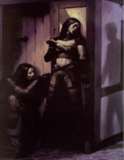1
Creations & Ephemera / Re: kickstarter for planescape torment successor
« on: April 01, 2013, 10:23:46 AM »
Thanks for posting the link. It seems quite interesting.
This section allows you to view all posts made by this member. Note that you can only see posts made in areas you currently have access to.





 . Spell reflection is an awesome ability, too.
. Spell reflection is an awesome ability, too.